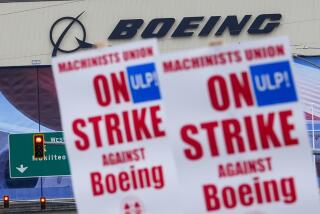A Lesson for Labor From American Airlines’ Strike : Unions: The power shifts to workers, but will their leaders come up with the competitive strategies to use it wisely?
- Share via
The agreement by American Airlines and its flight attendants’ union to accept binding arbitration as proposed by President Clinton represents a new era in airline labor relations, an era where power has shifted decidedly to the union corner but where labor may not be sure what to do with it.
The carriers gained the upper hand in bargaining in the 1980s by hiring permanent replacement workers during strikes. They kept the airlines flying and then kept the jobs when the strikes ended. This tactic began with the Wein Air strike in 1977--four years before the air-traffic controllers strike--and has continued ever since.
It has, however, been an open secret in the airline industry since the pilots’ strike at United in 1985 that the carriers were becoming too big to use this tactic effectively. A carrier like American simply cannot hire and train the 20,000 permanent replacement flight attendants it would need to restaff the airline before the revenue losses of a strike would do irreparable damage. And flight attendants are the easist group of airline workers to replace. Unlike manufacturing and other industries that can stockpile product before a strike or make up business afterward, airlines lose all their business when shut down and frequently find it difficult to regain their markets afterward.
So the airlines now have to rely on getting workers to cross picket lines in order to beat strikes. When the unions keep their membership together during strikes, as the flight attendants did at American, the carriers are in big trouble. The party asking the government to step in and end a strike is generally the one with the most to lose from confrontation. Recent reports that American initiated the request for intervention suggests that the carrier was relieved to have the President offer them a way out.
After a decade of beating the unions at the collective bargaining game, the carriers now face an embittered labor movement with a long memory and the power to get its way. The union demands at American, for example, turn as much on the concessions of the past decade as on any current issue.
The result is that the airline industry may have the most confrontational labor relations in the United States today. Unlike other industries such as autos or steel, most airlines have no quality-of-worklife programs, no mutual-gains bargaining and no joint labor-management committees. The reason is the inability of either party to articulate a vision of the future that includes common goals. The unions rightly claim that their concessions over the past decade did the carriers no long-term good, as virtually all of the savings were passed through to consumers in the form of lower fares. Management, on the other hand, finds itself inevitably teetering on the financial brink, needing continuous cost cuts to meet ever lower fares in order to keep the planes full.
The need to meet foreign competition helped create common goals in manufacturing: Greater productivity would help take back markets that would help ensure greater job security and, possibly, wage growth. But because the airlines are competing with each other for the domestic market, often dealing with different locals within the same unions, the notion of gaining market share has a distinctively zero-sum feel to labor.
With the carriers so financially vulnerable, labor finds that even when it has power, it is difficult to use it for traditional wage-and-benefit improvements. In the absence of a strategy from management that meets any of labor’s needs, the unions have pushed themselves into the management suite. At TWA and Northwest, labor swapped concessions that kept those carriers going in return for stock ownership and significant control over management decisions. The unions at United are now in their ninth year of efforts to achieve the same end by purchasing the company.
Whether labor will be any better at fashioning competitive strategies that also meet worker needs is an open question.
The government can do two things to help. The first is to help U.S. carriers expand into world markets so that they can grow in ways that are not simply at the expense of each other. The second is to continue what the President began: Call the parties together and help them understand and outline some common goals. In particular, growth in international markets will turn on two things: quality of service, which is dependent on morale and is damaged by confrontational labor relations; and cooperation for productivity sufficient to fund wage increases.
More to Read
Inside the business of entertainment
The Wide Shot brings you news, analysis and insights on everything from streaming wars to production — and what it all means for the future.
You may occasionally receive promotional content from the Los Angeles Times.










